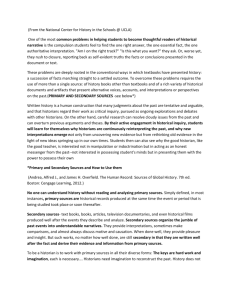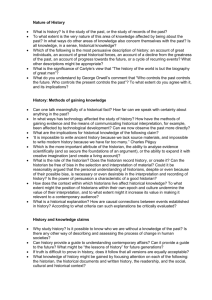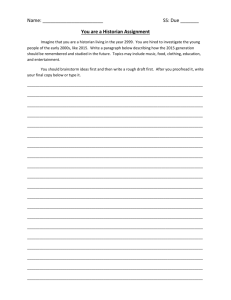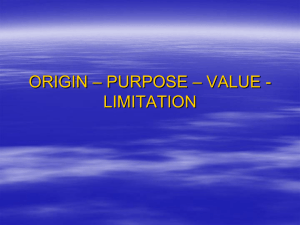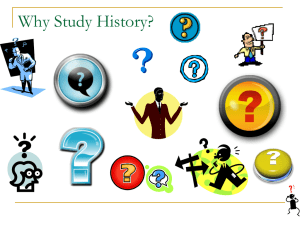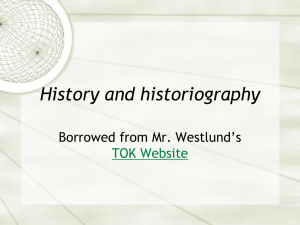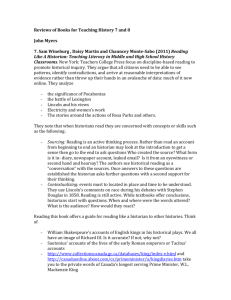File - AndAllThat.co.uk
advertisement
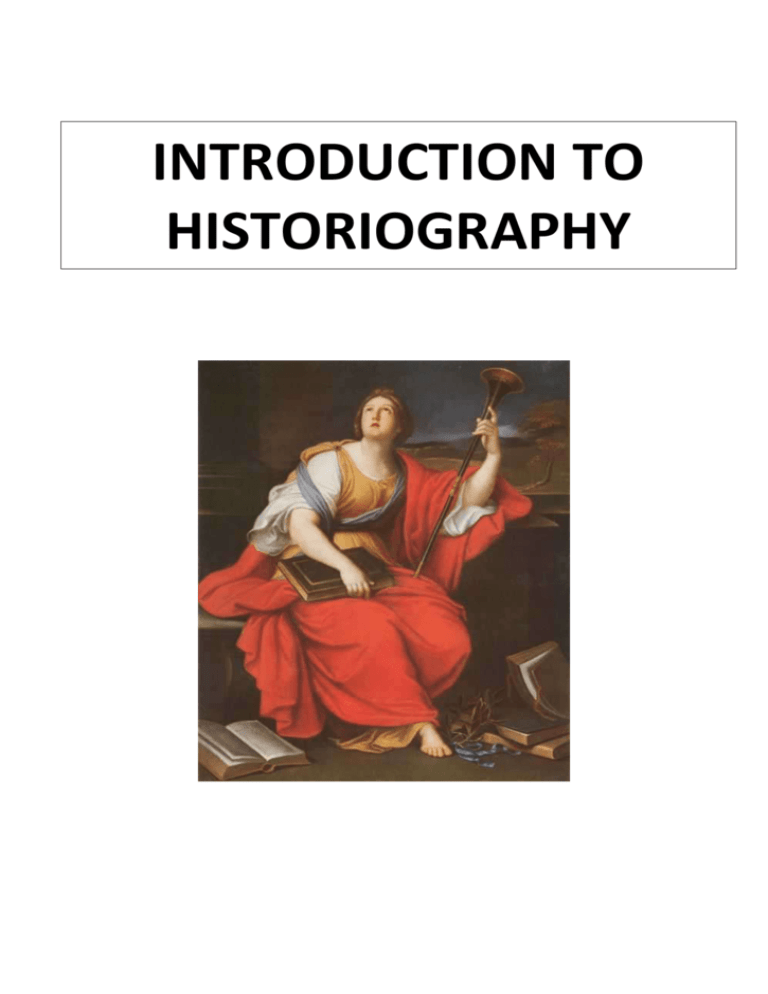
INTRODUCTION TO HISTORIOGRAPHY Introduction to Historical Controversies Why does historical controversy arise? The historian’s personal view of society and the past The influence of the present social/ political/ cultural climate on the historian The historical method used by the historian (e.g. reconstructive, analytical) The historical approach of the historian n(e.g. Marxist, feminist, cultural) The different types of evidence used and how they have been interpreted by the historian Incomplete/ contradictory evidence The questions asked by the historian Historical evidence The problem that every historian confronts is that the evidence they rely on is likely to be fragmentary, incomplete or contradictory. As a result, each historian’s conclusions are influenced by the evidence they have selected from what is available and how they have interpreted that evidence. Each generation of historian has access to a different range of evidence – some existing evidence may have been lost and some new evidence may have been discovered. This means that historians will never know everything that happened in the past. Historical questions and approaches Historians approach evidence with their own agenda: they don’t all ask the same questions of the same evidence. For example, a gender historian will ask different questions on the evidence for witch – hunting in early modern Europe than a religious historian, because they are looking for different things. Their approach to the evidence is also influenced by who the historian is as a person – i.e. their gender, ethnicity, religion, political beliefs – and by the age in which they live. Examples of historical approaches: Political Social Economic Cultural Gender Local Comparative Total Class relations History ‘from above’/ ‘from below’ History of mentalities All historians want to make sense of the past but, because life in the past was so complex, they often try to simplify things by categorising the past artificially (e.g. it was a 19thC Danish museum curator who ‘invented’ the terms Stone/ Bronze/ Iron Age to help him sort out his ancient artefacts). The periods in which the history of Western Europe has been divided have also been invented for the convenience of historians – e.g. stating that the ‘medieval’ period ended at Bosworth Hill (the death of 1 Richard III and the beginning of the Tudor Age) is a gross over – simplification, but helps give some shape to the otherwise amorphous past. Dividing the past into centuries is problematic, as ‘ages’ often straddle these time divisions: Were the late 1490s (medieval) really so different from the early 1500s (early modern)? Some historians would say that the 19thC really began in 1793 and that the 20thC didn’t start until 1914 Was 1991 (ending of communism) more of a turning point than 2000? Historians also label the peoples of the past, as well as the periods – e.g. ‘peasant’, ‘radicals’ or ‘Protestants’. However, this suggests that all people in that group had the same outlook, values or life experiences, when that plainly will not be true. Whig History This term is often used to denote a triumphalist view of the past, linked to the notion of progress. It developed in Britain in the 19th century, and is linked with historians such as Macauley. ‘Whig’ comes from the term ‘whiggamore’, who were Protestant supporters of William and Mary during the ‘Glorious Revolution’ (1688). This view of history celebrates the creation of the institutions of modern Britain (e.g. parliamentary democracy, the rule of law, constitutional monarchy) through a series of struggles and triumphs over time. This way of looking at the past was influenced by Darwin’s Evolution of Species. Whig historians would see the English Civil War and its aftermath as part of a heroic struggle for political and religious liberty, whereas more recent historians would see it as a desperate attempt by the old rural elite to restore their former status. The Whig view of history has also been adopted by some historians of the American West, who see the ‘conquest’ of the West by white Americans as part of the country’s ‘Manifest Destiny’. What is History? G. R. Elton (leading Tudor historian of 1950s/60s; uncle of Ben): A search for truth Keith Jenkins (leading historian on belief and superstition in early modern England): A collection of views about the past ‘History’ could be said to be simply historiography = the history of history writing 2 Historians encounter, analyse and revise the interpretations of their predecessors, which build up like layers of sediment: The present ‘Counter –revisionist’ interpretations ‘Revisionist’ interpretations Traditional/ orthodox interpretations of those events The past (i.e. the actual events) Historical interpretations Postmodern theorists would say that to attempt to search for objective truth about the past in misguided (we can’t know what happened in the past because we don’t have the same mind-set/ mentality as those who lived through it), and historians should instead focus on the process by which written history is created. Medieval historians said that God caused everything. However, after the Enlightenment (late 18thC), ‘reason’ replaced superstition and so new explanations for why things happened had to be found. There are two real alternatives: 1. Everything is the product of chance/ random circumstance 2. Create new determinist theories (i.e. historical events are predetermined by certain forces) A.J.P Taylor (historian of the Second World War) would agree with the first alternative. He famously stated that history is simply a series of accidents and blunders. Others find theoretical explanations for events dangerous and/ or misleading, because they remove the power of human agency and can allow individuals to avoid blame for the consequences of their actions (e.g. saying the Holocaust was caused by the popularity of ‘Social Darwinism’ in post – WWI Europe absolves Hitler of any censure). It is also undeniable that chance plays some role in history – e.g. natural disasters (the Icelandic volcano Eyjafjallajökull that erupted in the 1780s led to a series of bad harvests that caused high bread prices and, eventually, the French Revolution) or epidemic diseases (the Black Death led to a shortage of labour in England, which meant that the survivors could charge a higher rate for their work, and eventually to the end of feudalism). Examples of deterministic theories of history: 1. Intentionalist = history is driven by human agency (e.g. Hugh Trevor – Roper would argue that WWII was the result of Hitler’s master – plan as set out in ‘Mein Kampf’) 2. Structuralist = history is the result of ‘base structures’, such as the economy or the environment; above these are ‘super – structures’ such ideas/ institutions/ events Historical determinism Whilst 19thC historians would say that history is shaped by ‘great men’ (e.g. kings and prime ministers), many modern historians tend to look instead for the (non – human) dynamic forces that have shaped history, the underlying trends/ structures. Examples: 3 1. Marxism 2. Frederick Jackson Turner’s ‘Frontier Thesis’ of American history Marxism: This is the most influential deterministic theory of history. Marx argued that the force that leads to all historical change is the struggle between social classes. This struggle is caused by an unequal economic relationship between two classes. Eventually, the oppressed class (the proletariat – industrial working class) will rise up against the oppressing class (the bourgeoisie – the owners of the means of production) and usher in a communist society. This would mark the ‘end of history’, as there would be no more struggles in a classless society. Marx and Engels identified 3 stages through which all human societies must pass before they develop a communist economic structure and therefore end class conflict: Stage 1: Ancient (slave – driven economies; e.g. Rome) Stage 2: Feudal (lord and serf system of obligations tied to land) Stage 3: Bourgeois (modern capitalist economy) Communism would emerge from the overthrowing of the capitalist system and the destruction of the concept of class by giving producers communal ownership of everything they produced; until this stage, the mode of productions was bound to lead to conflict. Marx, therefore, challenged the view that the ideas/ actions of men and women shaped their destinies. Turner’s Frontier Thesis: The drive to extend the frontier of white settlement was the underlying cause of America’s expansion into the west during the 19thC (e.g. it wasn’t the result of a decision taken by the government or by individuals’ groups) Both these interpretations are examples of a ‘metanarrative’ – a text/ principle/ myth used by a society to explain its past and present, to help unite that society in a common purpose. Examples of metanarratives are the Bible, the Communist Manifesto and witchcraft. In recent years, Marxist interpretations have fallen out of favour, following the collapse of the USSR, as well as increasing living standards in Western countries, meaning that ‘class conflict’ is seen as no longer relevant. Modern historians are also much less convinced that history is the story of human progress. For example, Whig historians would have seen the Renaissance and Reformation (which replaced feudalism and superstition) as marking the start of a lasting period of progress. However, modern historians would point out that there were a series of crises during the 17thC that arguably led to a period of stagnation/ regression (e.g. the Thirty Years’ war; the English Civil War). 4 HISTORIOGRAPHY - OVERVIEW View on Role of History Methods of Creating History FREE WILL POSITIVISM People in the past were in full control of their own destinies – lessons can be drawn Embraces human agency in history. Uses sources to provide and accurate and complete vision of the past. Also embraces and empathetic approach towards people in the past. CHAOS THEORY NARRATIVE - CHRONOLOGY Lessons cannot be drawn from the past as there is no path to history The creation of narratives of the past – analysis plays less role as the role of accidents is most important. AJP Taylor used this approach in series on Russia. INTENTIONALIST TELOLOGY BIOGRAPHY - HAGIOGRAPHY The “Great Men” method which creates chronological narratives. Often look at the agency of one individual in history. HEGELIAN Lessons can be drawn from history because it has a path which we can choose to follow or change HISTORICIST (LATE C19TH) A scientific approach to history pioneered by von Ranke/ Based on the objective study of primary sources. Believed that the study of such sources would allow a reconstruction of history “wie es eigentlich gewesen ist” – as it actually was. View on Sources Sources can ad should be used to reconstruct the past. Schools of Historiography ACCIDENTALIST Intentions and personalities of key individuals drive historical change eg. Hitler’s master plan created and caused the Holocaust Intellectual movements and the progress of ideas are the driving force in historical change. Hegel saw history as a constant progression towards true freedom. Studies of ideas such as the Renaissance are often Hegelian in character. MARXIST Economic forces are the main driving force in historical change. Karl Marx relied heavily upon statistical data to show that exploitation and class conflict drove history. Eg. Studies of the Peasants’ Revolt which focus on prices of bread and declining wages. STRUCTURALIST Political and military structures are the main driving force of historical change. Also known as a functionalist position. Eg. The city states of the Italian Renaissance and the absence of Church allowed the Renaissance to flourish. ANNALES Named after Annales d'histoire économique et socialeand pioneered by historians such as Lucien Febvre and Marc Bloch. Heavy use of social sciences in historiacal explanation rather than looking at political structures etc. A downplaying of short term events and a focus on the longue duree. Belief that environment and culture shape history over the long term and that history defies categorisation. Eg. A long term study of the belief that the kings of France could cure Scrofula. Use of sources not the main focus – more of a focus on why things happened rather than what happened Believe that accidents are the driving force of historical change: a mosquito bite prevented Trotsky being fit enough to seize control of the USSR; a change in wind direction prevented the Spanish Armada from arriving in England etc. Theses are created which become orthodoxies. New theses then arrive to challenge these – revisionism – and a synthesis is produced from the old and the new. The synthesis becomes the new thesis or paradigm and the process of clashes (dialectics) repeats. DETERMINISM Lessons cannot be drawn from history because it has a path which cannot be changed Sources cannot be used in reconstructing the past. POSTMODERNIST (LATE C20TH) Foucault argued that all historical sources are biased, incomplete and that the language has no fixed meaning. He therefore suggested that the past was unknowable. A belief that all interpretations of history are equally valid… DIALECTICS - ANALYSIS 5 META-NARRATIVE – TOTAL HISTORY Works of the Annales school are characterised by a multi-layered approach which seek to integrate long-term, mid term and short term factors in a “total history”. There is an effort to explain large amounts of human history through the application of theory and social sciences. Comparative studies of similar events in disparate places PHILOLOGY NEGATIVISM The study of language is used to pull apart texts to highlight ambiguities – no lessons Rejects human agency in historical affairs. Rejects all sources. Rejects the possibility of empathetic understanding of the past. 6 7 8 Working with historical interpretations Working with historians’ interpretations can be a difficult task. Part of the craft of being an historian is in presenting your findings so they appear to be irrefutable facts. As part of your A2, you will be asked to read a whole range of historical arguments in building your Personal Study. If you are not careful you can quickly become bogged down in detail and miss the larger points being made by the historian. The steps below should help you to be aware of the historians you are reading and the agendas they might be pursuing. Stage 1: Executive Summary The most important part of reading any extract is in making an executive summary. This essentially identifies the main points of the historian (their INTERPRETATION) Armed with your YELLOW (INTERPRETATION) highlighter, read through the extract and highlight any key points being made. As you do this you should make a set of notes in the interpretation box of your cover sheet. You should try to paraphrase and put the historian’s points into your own words. A good quality summary is vital for discussion. Make a note of good quotes and key page numbers. It may also be helpful to think about how these points link with other things you have read, or what you already know and note these down too… Stage 2: Establishing the Main Themes Once you have got the main points made by the historian, you then need to think about how these group together. Do your notes for easily into larger, more over-arching points? You might find a number of the little points you identified fit under a larger heading that: “the West was shaped by the Frontier process” for example. These larger points will form the main structure of your writing so that you show a command of the argument as a whole. Stage 3: Methods Once you have worked through the extract for meaning, you can now look a little deeper. You might like to highlight these together rather than doing it in two stages. Again make notes on your cover sheet as you go. Try to highlight in GREEN any parts of the text which show the METHODS used by the historian. This might include: Types of source material used: primary, secondary, ethnic, white, anthropology, social sciences, statistics etc. The way the findings have been presented – is it narrative, analytical etc. Make a note of these methods, think about how they compare to other methods and consider the impact they might have on the interpretation. Stage 4: Purposes and Approach The key to “Approach” is trying to work out what the historian set out to do. What questions was the historian asking and trying to answer? Why did the historian write the extract, to support an orthodoxy, revise one, create a new one? Do they have a focus? Do they want to ask the reader a question? Do they have an agenda – a contemporary issue which they are highlighting through the history? Eg. Goldhagen tries to prove that the Nazi elite, whilst clearly to blame for the Holocaust, could not have been successful without the support of ordinary Germans. He is attempting to revise an orthodox view of Germany. BE AWARE – the purpose and approach of the historian are seldom the same as what they choose to write about You should highlight any clues about the approach of the historian in PINK. Remember this is how they look at the topic as well as the schools of history they might fit into eg. Stucturalist/Internationalist/Economic/Social/Cultural/from Above/from Below 9
